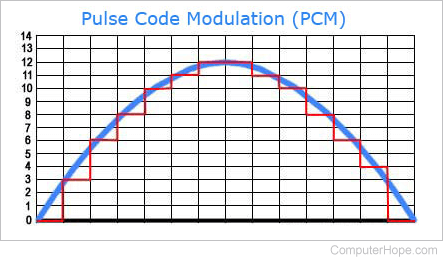PCM
Short for pulse-code modulation, PCM was developed by Alec Reeves, a British engineer in 1937. It is an analog signal that's sampled at uniform intervals and converted to a digital binary number. The technology was created for telephone communication system. However, today is also used with other digital audio formats such as audio CDs, DVDs, and Blu-ray discs.

Above is a basic graphic example of what occurs during the pulse code modulation process. The blue line is an example of an audio signal, or sine wave, and the jagged red line would be digital representation of that line. In this example, the sampling points would be 0, 3, 6, 8, 10, 11, 12, 12, 12, 11, 10, 8, 6, 4, and 0 or in binary: 00000000 00000011 00000110 00001000 00001010 00001011 00001100 00001100 00001100 00001011 00001010 00001000 00000110 00000100 00000000.
Analog, Binary, CD terms, Computer abbreviations, Digital, Electronics terms, Red book
